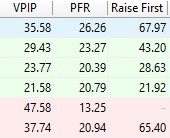The use of player statistics in online poker may not be as popular as it once was, but it is still an important tool the best poker players know how to use.
When it comes to poker stats derived from programs like PokerTracker and Hold’em Manager, few are as important and useful as PFR.
Using the PFR stat, you can help determine player tendencies and adjust your play to increase your profit against various player types.
In this article, I am going to teach you what the PFR poker stat means, how you can use it to your advantage, and what adjustments in your game you can make depending on a player’s PFR.
Let’s start by explaining the basic meaning behind the PFR poker stat.
What Is PFR in Poker?
Like most stats in poker tracking software, PFR is an abbreviation, and it stands for “pre-flop raise.” PFR changes based on how often a player raises before the flop.
Of all the stats used in online poker, PFR is probably the second most important one, right behind VPIP. This is why most HUDs show PFR in the first line, right next to VPIP.

It is important to remember that a player’s PFR stat changes every time they take an action before the flop. If the action is aggressive, PFR goes up. If the action is passive, PFR goes down.
This means that PFR will grow if the player makes a re-raise as well, which means it acts as a cumulative stat to determine a player’s overall preflop aggression and helps you make more informed assumptions about your opponent’s preflop range.
The best players in the game are quite aggressive, but finding a PFR that is too high can be just as useful as finding one that is too low.
Before we look too deeply into how to interpret the PFR numbers, let’s talk about the relation between PFR and the other essential stat, VPIP.
Relation Between PFR and VPIP
One of the most basic ways to use the PFR stat in poker is by comparing a player’s PFR with their VPIP and looking for major discrepancies.
The VPIP stat stands for “voluntarily put $ into the pot,” and it depicts all the times a player enters a pot without being forced to by the blinds.
If playing correctly, a player should have a VPIP stat that is slightly higher than PFR but not too much higher.
Playing a high VPIP in the first place usually signifies a pretty bad player, but one with a high VPIP and a low PFR is usually the worst kind of fish out there.
In the section below, I will explain how you can compare a player’s VPIP and PFR to determine their general tendencies and player type, but before we do that, let’s talk about how your PFR stat should look if you are playing good poker.
How High Should My PFR Be?
While tracking everyone else’s stats at the tables, you should also track your own. This helps you make sure you are playing a strong strategy without major holes in it.
In fact, your stats can be the best way to find leaks in your game, as they will quickly show you which areas of your game you may be making mistakes in. Basically, your data will help you improve your poker strategy.
The PFR stat is of essential importance, and good poker players all have very similar numbers when it comes to PFR, just as they do with VPIP.
Generally speaking, good players in modern six-max games play a VPIP of about 25 and a PFR of about 20, and these numbers can go up and down a few points depending on several factors.
For starters, some players just play a slightly more aggressive style, and there is nothing wrong with that if you know how to execute it correctly on later streets.
Furthermore, the tendencies of the overall player pool play an important role here. If your opponents are very tight, playing a higher PFR makes sense. If they are very loose, you will want to play a lower PFR.
One thing that should not change, however, is the relation between your VPIP and PFR, as playing a much higher VPIP than PFR means you are playing quite passively, and this is never the right way to play poker.

Whether you play a tighter or looser preflop strategy, you should always be playing aggressively and only taking passive actions some 25 to 30% of the time while being aggressive the rest.
Of course, these numbers can all be deviated from in tournament poker and at lower stack depths, but starting from a baseline of 100 big blinds is the best way to learn about anything in poker.
Identifying Player Styles Based on PFR
The most practical use of the PFR stat at the poker table is to ascertain player styles quickly. In order to do this, you will first need to play a certain number of hands against a player.
Having at least a couple of hundred hands played against a player should give you some clue as to their tendencies. Playing a few thousand will give you VPIP and PFR numbers that are just about right for their overall game.
Once you see the players’ VPIP and PFR at a six-max cash game table, you can start classifying players into types:
- Maniac: If you see a player with a VPIP of 50 and PFR of 40 at your table, you are dealing with a maniac. This player raises whenever given a chance, and your best bet is to play back at him often with a strong range of hands while opening a tighter range if they have a position on you. A hand like KQs or TT is a monster against this guy’s re-raise.
- Calling Station: This player plays a lot of hands but usually plays passively. A typical calling station might be playing 40/13, which means they call 40% of all hands but only raise 13% of the time. Be cautious when facing a raise from this player but run them over all the numerous times they just call before the flop.
- Nit: Players with both low VPIP and PFR are typically called nits, and they are quite uncommon in online games these days. If you do encounter a nit with stats like 11/9, remember to steal their blinds with any two cards and only play against their raises with strong hands and great drawing hands that have the potential to stack them. A nit’s open is almost always strong, and his re-raise is always a monster.
- TAG: Tight-aggressive (TAG) players are quite common and tend to be pretty solid after the flop, but they play a strategy that’s too tight before the flop. A TAG player might be playing 18/15, which means they play too few hands but almost always play them aggressively. You can discard some of the hands you would be playing from their range across the board, but approach them as a competent player not to be taken too lightly.
- Solid Reg: While many different playing styles can work at the poker tables, most players these days train a style of poker that makes their 6-max stats about 25/20. Slightly higher or lower than this still probably means they are pretty good, while serious deviations from either number usually mean they are not playing a style of poker played by the big winners in online cash games these days.
Looking at PFR by Position
The overall PFR number tells us a lot about our opponents’ tendencies, but we can get even more information by looking at more specific stats, such as PFR by position.

By looking at the HUD popup, you can see more detailed PFR stats for a particular player, with PFR broken down by table positions.
These numbers will tell you what percentage of hands a player raises from various positions, such as UTG, D, or SB.
Whenever you face a raise from an opponent with unusual overall stats, take a few seconds to look at that popup and find out what their PFR from that particular position is.
This number can help you determine their approximate opening range even further, and this can help you formulate a better strategy to counter theirs.
Putting PFR Into Practice
So you have had a look at a player’s VPIP and PFR stats, and you have identified their player type, but how exactly does it help you?
Well, there are quite a few ways these stats can help you beat your opponents. Mostly, they will do so by helping you narrow their ranges in various situations.
For example, imagine playing against a nit who raised from UTG with stats of 12/10. This player only raises with 10% of hands from all positions, but they raised from UTG in this hand. What does that tell you?
Naturally, the low number tells you that it is extremely likely the player is holding a monster. You could imagine their range is JJ+ and AK+ in this particular spot, as rare as it might be.
On the other hand, a player with stats of 52/45 raising from the cutoff tells you that the player’s range is extremely wide, making it vulnerable to being played back at.
If this player raised 50% or more of all hands in this spot, which is very likely, you can re-raise them with an extremely wide range and expect to get many fold, as well as many continues from weak hands.
Whether they fold or call too much after getting raised in this spot can be ascertained by looking at their “fold to 3-bet” stat, and you can use other stats to find other similar leaks in your opponents’ games.
When studying your sessions after you play, make sure to look for opponents who have unusual PFR and other stats and try to figure out the main leaks in their games you can use the next time you sit down at the table with them.





